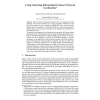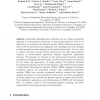EUC
2005
Springer
14 years 5 months ago
2005
Springer
Wireless sensor networks are capable of carrying out surveillance missions for various applications in remote areas without human interventions. An essential issue of sensor netwo...
DCOSS
2005
Springer
14 years 5 months ago
2005
Springer
In this paper we address a well-known facility location problem (FLP) in a sensor network environment. The problem deals with finding the optimal way to provide service to a (poss...
DCOSS
2005
Springer
14 years 5 months ago
2005
Springer
The literature on programming sensor networks has focused so far on g higher-level abstractions for expressing local node behavior. Kairos is a natural next step in sensor network ...
DCOSS
2005
Springer
14 years 5 months ago
2005
Springer
Sensor network localization continues to be an important research challenge. The goal of localization is to assign geographic coordinates to each node in the sensor network. Locali...
DCOSS
2005
Springer
14 years 5 months ago
2005
Springer
Abstract. Many sensor network applications demand tightly-bounded object detection quality. To meet such stringent requirements, we develop three sensing scheduling protocols to gu...
DCOSS
2005
Springer
14 years 5 months ago
2005
Springer
Distributed embedded sensor networks are now being successfully deployed in environmental monitoring of natural phenomena as well as for applications in commerce and physical secur...
SENSYS
2005
ACM
14 years 5 months ago
2005
ACM
Sensor networks have the potential to greatly impact many aspects of medical care. By outfitting patients with wireless, wearable vital sign sensors, collecting detailed real-tim...
SENSYS
2005
ACM
14 years 5 months ago
2005
ACM
Despite their increasing sophistication, wireless sensor networks still do not exploit the most powerful of the human senses: vision. Indeed, vision provides humans with unmatched...
SASN
2005
ACM
14 years 5 months ago
2005
ACM
Sensor network has a great potential in applications such as habitat monitoring, wildlife tracking, building surveillance, and military combat. The design of a sensor network syst...
PEWASUN
2005
ACM
14 years 5 months ago
2005
ACM
Underwater sensor networks will find applications in oceanographic data collection, pollution monitoring, offshore exploration, disaster prevention, assisted navigation, and tact...


